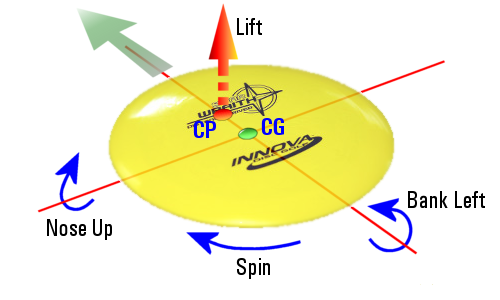This is great!! Why didn't I read this thread before?! Ok, so I spent a few hours going over all the really well-collected stuff you put together, Olorin. I just couldn't put it down. I think I have an understanding of some things.
I think I'll try to explain my understanding. You may already be past all this, but it helps me to write it out anyway. I'll try to make it readable and not get too precise about terminology and stuff, especially since my grasp on this isn't too great yet.

Please, correct me if I'm wrong!
It'd be helpful to look at this image when reading:
http://picasaweb.google.com/orcsroc/DiscAerodynamics#5319157673425650690
1. Why does a disc turn?
The center of pressure (ie, where the lift force is centered; CP in the image) is ahead of the center of gravity (CG in the image). That means the lift generated by the disc tends to make it rotate (ie, a torque will be applied) in such a way that the nose goes up or down (Nose Up in the image). So if the disc was thrown without spin, this would cause a rapid change in pitch: basically the disc would flip end-over-end and not go anywhere. But because the disc is spinning, it behaves like a gyroscope. Torque applied to a gyroscope along its axis of spin cause rotation at right angles to the axis (called gyroscopic precession). What this means for the disc is the torque that would change the pitch actually cause it to roll. Or in terms of the image, the spin transfers "Nose Up" torque into "Bank Left" torque.
2. Why does a disc turn right at high speeds?
The disc turns right at first because at angles of attack near zero (ie, nose flat), the flight properties of the disc actually makes it pitch nose down. So the precession or spin transfers nose down torque (aka negative "Nose Up") to bank right torque (aka negative "Bank Left").
This happens more at high speeds because lift is proportional to the square of velocity. So if you throw twice as fast, the disc will generate four times the lift. Lift is the force ultimately causes the roll, so more speed means more lift means more roll.
3. Why does a disc fade left at low speeds?
The disc fades left late because the angle of attack increases over the flight of the disc (see #5). At angles of attack over 10 degrees or so (depending on the disc), the flight properties of the disc make it pitch nose up - relatively hard, too, as the angle of attack increases past 10 degrees. Again the precession transfers this "Nose Up" torque into a roll to the left.
4. Why do some discs turn or fade more than others?
The disc shape and mold changes the flight properties of the disc to have varying centers of pressure, lift and pitch moments at different angles of attack. In the Potts and Crowther papers Olorin linked to, they tested three shapes: a throw-and-catch frisbee, a flat plate, and something in between those two. They each had very different flight properties, so there is a lot of play in disc design to give discs different flight properties. For example, I suspect a disc that holds its line (like the Buzzz) may have its center of pressure closer to the center of gravity, making less pitch torque which results in less roll. That's just speculation, but you can imagine the effect varying some of these properties would have on the flight of a disc.
5. Why does a disc's angle of attack increase during flight?
I don't know. I haven't seen an explanation for it, only a statement that it occurs. One idea is that there is a measurable roll moment when spinning, according to Potts and Crowther, which might pitch the disc because of precession.

